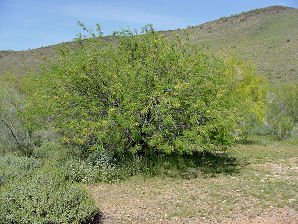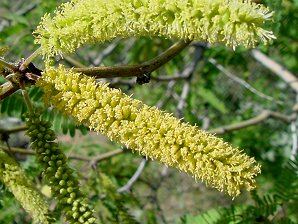Arizona Wild Flowers
Pictures, Photos, Images
Descriptions, Information, Reviews.
Velvet Mesquite, Prosopis velutina.
We Are Proud Of Our SafeSurf Rating!
Click On Any Of The Following Links By Amazon.Com
For Books, & Videos About Wildflowers Of Arizona & The Southwest USA. No Obligation!
| Velvet Mesquite, Prosopis velutina Photo Taken At Glendale, Thunderbird park. April 9, 2003. |
|---|
 | |
| Velvet Mesquite, Prosopis velutina. | Family: Fabaceae, Legume Family. |
|---|---|
 |  |
| These Flowers Produce Huge Amounts Of Nectar. | Honey Bees Produce Tons Of Honey From These Flowers Mesquite Honey Is Light Colored And Delicious!!! |
Velvet Mesquite.
We wish to thank Wikipedia, the free encyclopedia for some of the information on this page. We share images and information with Wikipedia. There are three common species of mesquite; the honey mesquite (Prosopis glandulosa), screwbean mesquite (Prosopis pubescens), and velvet mesquite. The velvet mesquite is the largest of the mesquite species. It is a low-branched, broad spreading thorny shrub or small tree with a well-developed crown. It can grow as a single-trunked tree about 30 feet tall, and just as wide, with a two feet diameter trunk. This native mesquite is easily confused with the non-native mesquites; the non-natives lack the jointy appearance of the twigs and branches, the non-natives are also more upright or erect.
A low-branched, broad spreading tree, sometimes a large shrub. They commonly grow in riparian areas, where they can form dense, shady riparian woodlands; known as mesquite bosques. Examples of these can be found at Butcher Jones Beach, Saguaro Lake, Arizona. Click Here To See Our Web Page Showing - Mesquite Trees - Butcher Jones Beach, Saguaro Lake, Arizona. The leaves grow alternately on the branch. The leaves themselves are bipinnate, compound, about 3-6 inches long, and pointed. The leaf has two sets of compound leaves, usually with four major leaflets and 10-20 narrow minor leaflets 1/3 to 1/2 inch long, which grow opposite each other on the stem. The leaves are dark to dusky green with a gray, hairy surface and paler undersides. The flowers are yellow-green, drooping catkins about 2-3 inches long. The flowers have bell-shaped calyces, and 5 petals. The flowers are tiny, but there are hundreds in a catkin. They have ahe flowers have a sweet, honey-like fragrance. The seeds are contained in straight or slightly curved, flat seed pods about 3-8 inches long. They grow singly, or in drooping clusters. Seed pods are straw colored, and are covered in short, velvety hairs when young. They mature 7-9 weeks after flowering. In Arizona they mature in July and drop in September. Note: The Seeds Of This Plant Are Edible � The dry, tan-colored bean pods have been used for centuries by the native americans of Arizona for flour to make breads and other types of foods! The seeds and seed pods can be ground into sweet, rich, nutritious mesquite flour. The beans can be boiled with meats, and the fragrant wood can be burned to flavor smoked and barbecued meat. Being a beekeeper - no pun intended - the author of this page, George knows that the Mesquite flowers attract numerous honeybees and that they are a source for lots of very delicious mesquite honey. Click Here To See Our Web Page Showing - Arizona Beekeeping With George DeLange. In fact, they produce more honey than most of the other sources of nector that George uses in his beekeeping. Many people barbeque with mesquite wood. It gives your food a wonderful smokey mesquite smell & taste. If you grow a mesquite in your yard, do not grow one near your swimming pool. They are not pool friendly. Mesquite trees are messy, they drip black sap, and have very adventurous roots Legally, Wild Velvet Mesquites are considered a protected plant, and are not considered to be weeds here in Arizona, they have been considered weedy when introduced into other areas where they are not native.
Quick Notes:
Height: About 20 feet. Can reach 30 feet, with equal spread.
Flowers: Pale yellow, sometimes cream colored; in a tight elongated, showy clusters, 2 to 3 inches long, fragrant, appearing in spring and early summer. Inflorescences, axillary spikes, biggest bloom in spring and early summer, then sporadic.
Flowering Time: April to June. Again in July - October, if there is the traditional summer rain called a monsoon.
Seed Pod: A slender brown pod, 3 - 9 in long 1/2in -1/4 in wide; edible, maturing in mid to late summer.
Stems/Trunks: An attractive gray shaggy - rough trunk; the twigs are jointy, branches gnarled and twisted.
Leaves: The leaves are bipinnately compound in pairs (two sets of compound leaves on stem), about 3-6 inches long, and pointed, with leaflets 1/3in to 1/2in long, which grow opposite each other on the stem. 14 to 30 pairs of leaflets per leaf; dark green to dusty green, slightly fuzzy texture, short gray hairs.
Found: Native to the Sonoran Deserts of California, the Southwestern United States, and northwestern Mexico.
Hardiness:
Soil pH requirements:
Sun Exposure:
Elevation: 0 - 5,000 feet.
Habitat: Well-drained sandy, gravelly, and rocky soils on moderate slopes, washes, flats, and canyons. in the lower & middle mountains. A most attractive and abundant plant along roadsides, plains, and mesas. In riparian areas, they can form dense, shady riparian woodlands; known as mesquite bosques. An ideal xeriscape landscape plant in Arizona.
Miscellaneous: Flowering Photos Taken At Glendale, Thunderbird Park, Arizona. April 9, 2003.
|
We Are Proud Of Our SafeSurf Rating!
Click On Any Of The Following Links By Amazon.Com
For Books, & Videos About Wildlife Of Arizona & The Southwest USA. No Obligation!
| © 1966 - Present, Audrey, Eve, & George DeLange |